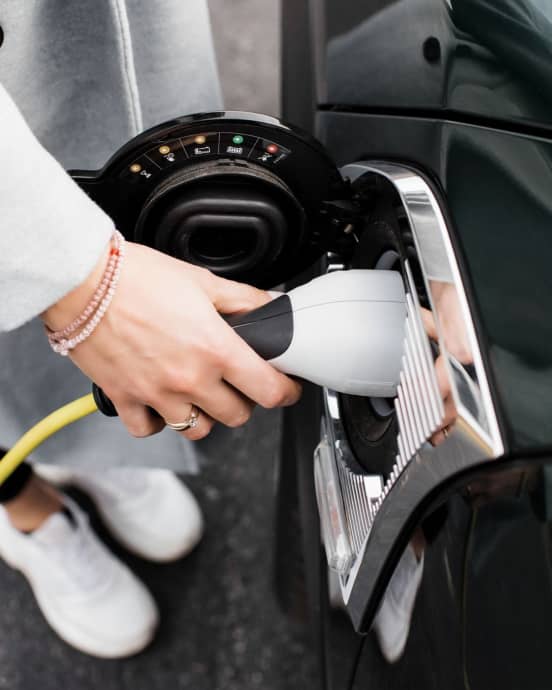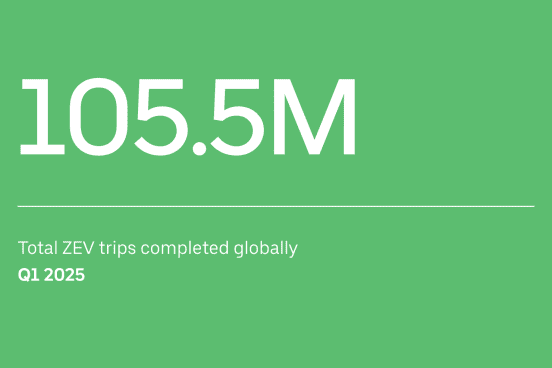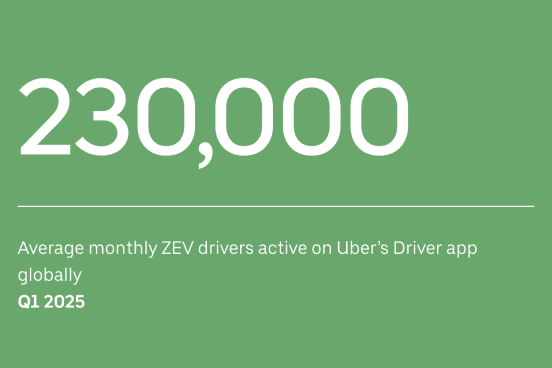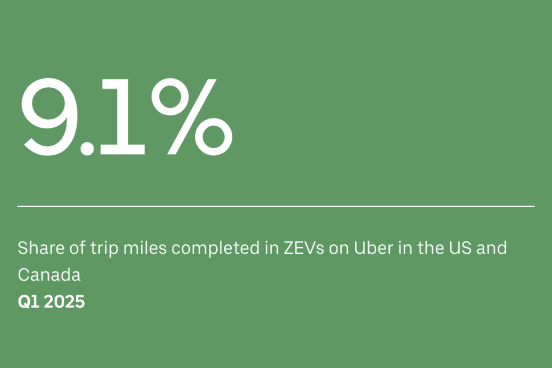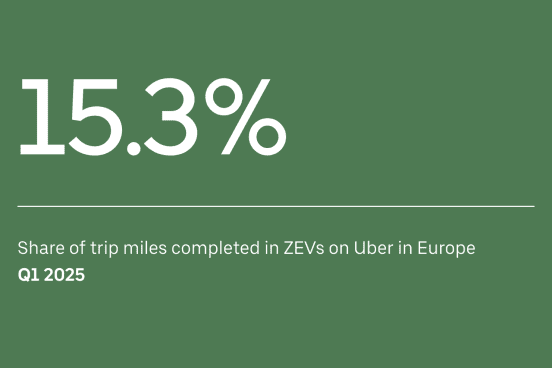Uber चे विद्युतीकरण अपडेट
"आमच्या शून्य-उत्सर्जन वाहतूक सेवा प्लॅटफॉर्ममध्ये परिवर्तन करण्याच्या महत्त्वाकांक्षी प्रयत्नांमध्ये अर्थपूर्ण प्रगती झाली आहे. आज, Uber हे शून्य-उत्सर्जन राईड्ससाठी जगातील सर्वात व्यापकपणे उपलब्ध असलेले प्लॅटफॉर्म आहे, जेथे ड्रायव्हर्स यूएस, कॅनडा आणि युरोपमधील सरासरी वाहनधारकांपेक्षा 5 पट वेगाने ईव्हीचा अवलंब करतात."
रेबेका टिनुची, Uber च्या इलेक्ट्रिफिकेशन अँड सस्टेनेबिलिटीच्या जागतिक प्रमुख अधिकारी
Q1 2025 अपडेट: या पेजवर 2021 च्या पहिल्या तिमाहीच्या सुरुवातीपासून ते 2025 च्या तिसऱ्या तिमाहीच्या शेवटपर्यंत Uber वर पूर्ण झालेल्या इंटर्नल कम्बशन इंजिन (ICE) वाहने आणि शून्य-उत्सर्जन वाहने (ZEVs, जसे की बॅटरी ईव्ही) च्या ट्रिप्सचे मेट्रिक्स समाविष्ट आहेत. या अहवालाच्या व्याप्तीमध्ये केवळ Uber च्या वाहतूक सेवा व्यवसायाचा (राइडशेअरिंग) समावेश आहे याची नोंद घ्या.
शून्य उत्सर्जनापर्यंतच्या आमच्या प्रवासाचा माग राखत आहोत
गेली पाच वर्षे आम्ही शून्य-उत्सर्जन प्लॅटफॉर्मवर जाण्यासाठी महत्त्वाकांक्षी प्रयत्न करून आम्ही अर्थपूर्ण प्रगती केली आहे. आज, Uber हे शून्य-उत्सर्जन राईड्ससाठी जगातील सर्वात व्यापकपणे उपलब्ध असलेले प्लॅटफॉर्म आहे, जेथे ड्रायव्हर्स यूएस, कॅनडा आणि युरोपमधील सरासरी वाहनधारकांपेक्षा 5 पट अधिक लवकर EVs (इलेक्ट्रिक वाहने) स्वीकारतात.
आम्ही इंसेंटीव्ह, भागीदारी आणि उत्पादन सुधारणांद्वारे इच्छुक ड्रायव्हर्सना इलेक्ट्रिक वाहने खरेदी करण्यात मदत करण्यासाठी लाखो डॉलर्सची गुंतवणूक केली आहे—आणि त्याचा फायदा होत आहे. वाढत्या प्रमाणात, रायडर्स Uber वर त्यांची पहिली EV अनुभवत आहेत, ज्यामुळे जगभरात इलेक्ट्रिक वाहतुकीचा अवलंब सामान्य करण्यात आणि वेग वाढवण्यात मदत होत आहे.
आमचा डेटा असे दाखवतो, की जेव्हा सरकार आणि उद्योग अर्थव्यवस्थेला सुरळीत ठेवण्यासाठी एकत्र काम करतात तेव्हा EVची वेगाने प्रगती होते. लंडन, व्हॅनकुव्हर आणि अॅम्सटरडॅम सारख्या शहरांमध्ये, जिथे विचारशील धोरणे, उद्योग गुंतवणूक आणि मजबूत चार्जिंग नेटवर्क एकत्र येतात, तेथे आता प्रत्येक 3 मैलांपैकी 1 पेक्षा अधिक मैलावर आता Uber इलेक्ट्रिक आहे.
ही लक्षणीय प्रगती असूनही, आमची उद्दिष्टे पूर्णपणे साध्य करण्यात प्रमुख अडथळे कायम आहेत. ईव्हीवर आगाऊ होणारा अधिक खर्च, मर्यादित चार्जिंग सुविधा आणि विसंगत धोरण सहाय्य यामुळे स्वीकार कमी होत आहे. सध्याच्या ट्रेंडच्या आधारे, आम्ही 2025 साठी आमची उर्वरित वाहतूक सेवा आणि डिलिव्हरी उद्दिष्टे पूर्ण करू शकत नाही आणि सरकार आणि उद्योगांवरील मजबूत, समन्वित कृतींशिवाय आमची 2030 ची उद्दिष्टे आवाक्याबाहेर असतील.
आम्ही सुरुवातीपासूनच म्हटल्याप्रमाणे: हवामान ही सांघिक लढाई आहे आणि प्रगती सामूहिक कृतीवर अवलंबून असते. म्हणूनच आम्ही सार्वजनिक आणि खाजगी गुंतवणूक एकत्रित असलेल्या शहरांमध्ये प्रयत्नांना अधिकाधिक प्राधान्य देत आहोत.
अनेक महत्त्वाची धोरणे आमच्या नियंत्रणाबाहेर असताना, आम्ही या परिवर्तनासाठी मनापासून वचनबद्ध आहोत—फक्त ही योग्य गोष्ट आहे म्हणून नाही तर यामुळे थेट आणि धोरणात्मक व्यावसायिक लाभ मिळतात. EV चालवण्यासाठी कमी खर्च होतो आणि रायडर्सची इलेक्ट्रिक वाहनांची मागणी करत असल्यामुळे जगभरातील हजारो ड्रायव्हर्स जास्त पैसे कमवत आहेत. रायडर्सना EV च्या अनुभवाबद्दल जास्त समाधान वाटते आणि ते अधिक प्रमाणात EV निवडत आहेत.
आणि शेवटी, भविष्य सामायिक, इलेक्ट्रिक आणि स्वायत्त आहे—आणि स्वायत्त (इलेक्ट्रिक) वाहनांची येणारी लाट आमची शाश्वतता उद्दिष्टे साध्य करण्यात मोठा हातभार लावेल.
खालील आमच्या नवीनतम अपडेटमध्ये 2025 आणि त्यानंतरची आतापर्यंतची प्रगती, मुख्य सखोल माहिती आणि लक्ष केंद्रित करण्याच्या क्षेत्रांची रूपरेषा दिली आहे.
__
रेबेका टिनुची, Uber च्या इलेक्ट्रिफिकेशन अँड सस्टेनेबिलिटीच्या जागतिक प्रमुख अधिकारी
7 मे, 2025
ZEV ड्रायव्हर्स
जागतिक स्तरावर, 2025 च्या पहिल्या तिमाहीत Uber च्या अॅपवर 230,000 पेक्षा जास्त ZEV ड्रायव्हर्स सक्रिय होते. ते एका वर्षाच्या आधीच्या याच कालावधीच्या तुलनेत 60% पेक्षा जास्त आहे.
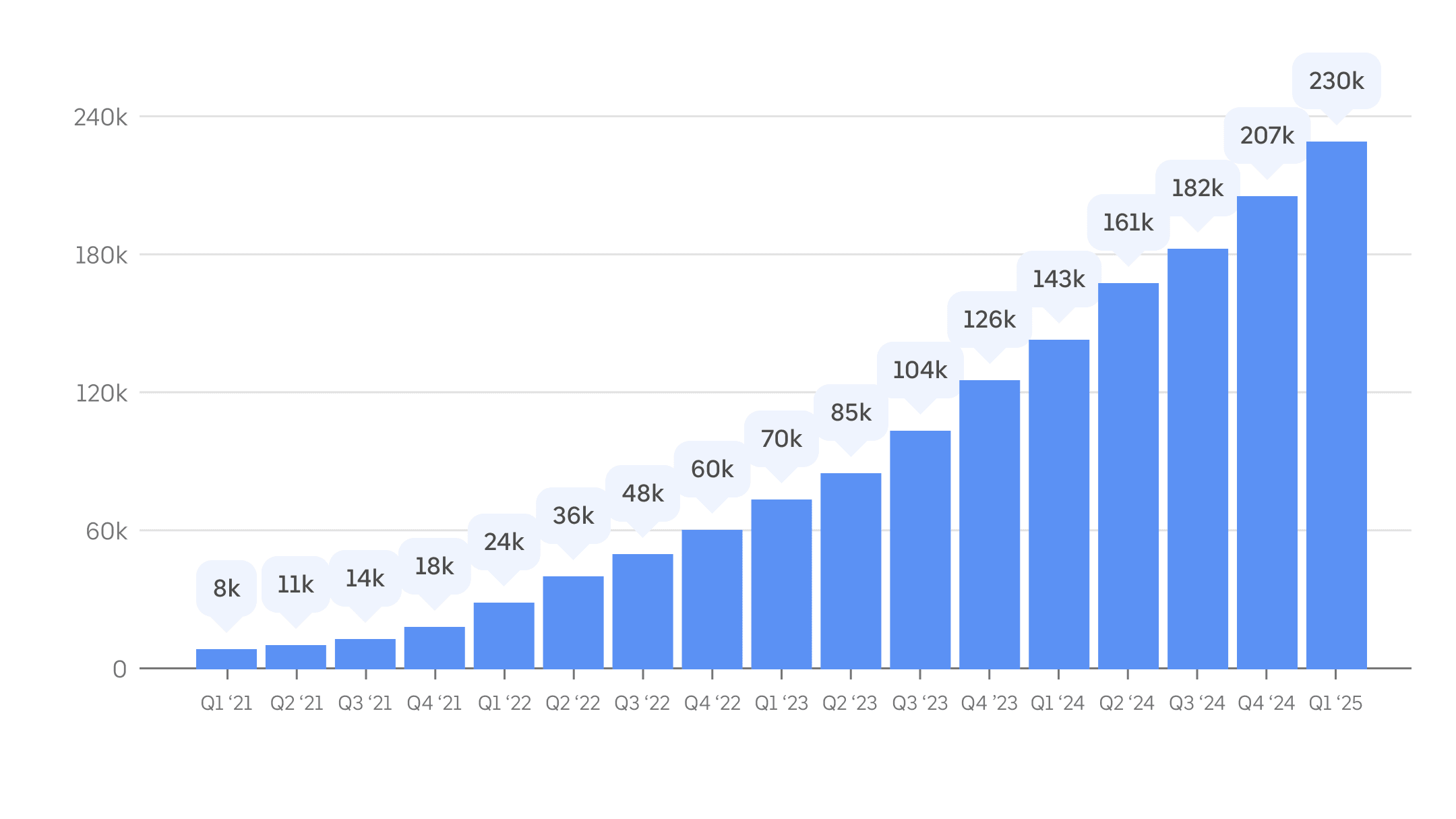
मेट्रिक: 2021 च्या पहिल्या तिमाहीपासून(Q1), Uber वर तिमाहीनुसार सरासरी मासिक सक्रिय ZEV ड्रायव्हर्स. Uber चे अॅप वापरणाऱ्या ड्रायव्हर्सनी कॅलेंडरमधल्या एखाद्या महिन्यात किमान एक ट्रिप पूर्ण केली असल्यास, त्या महिन्यात, त्यांची गणना ॲक्टिव्ह ड्��रायव्हर्समध्ये केली जाते.
ZEV ट्रिप्स
2025 च्या पहिल्या तिमाहीत(Q1) ZEV ड्रायव्हर्सनी जागतिक स्तरावर Uber वापरून 105 दशलक्ष टेलपाइप-उत्सर्जन-मुक्त ट्रिप्स पूर्ण केल्या—आधी वर्षभरातील याच कालावधीत Uber वर पूर्ण केलेल्या ZEV ट्रिप्सपेक्षा 60% जास्त. या Uber वर दर सेकंदाला सरासरी 13 ZEV पेक्षा जास्त ट्रिप्स आहेत.
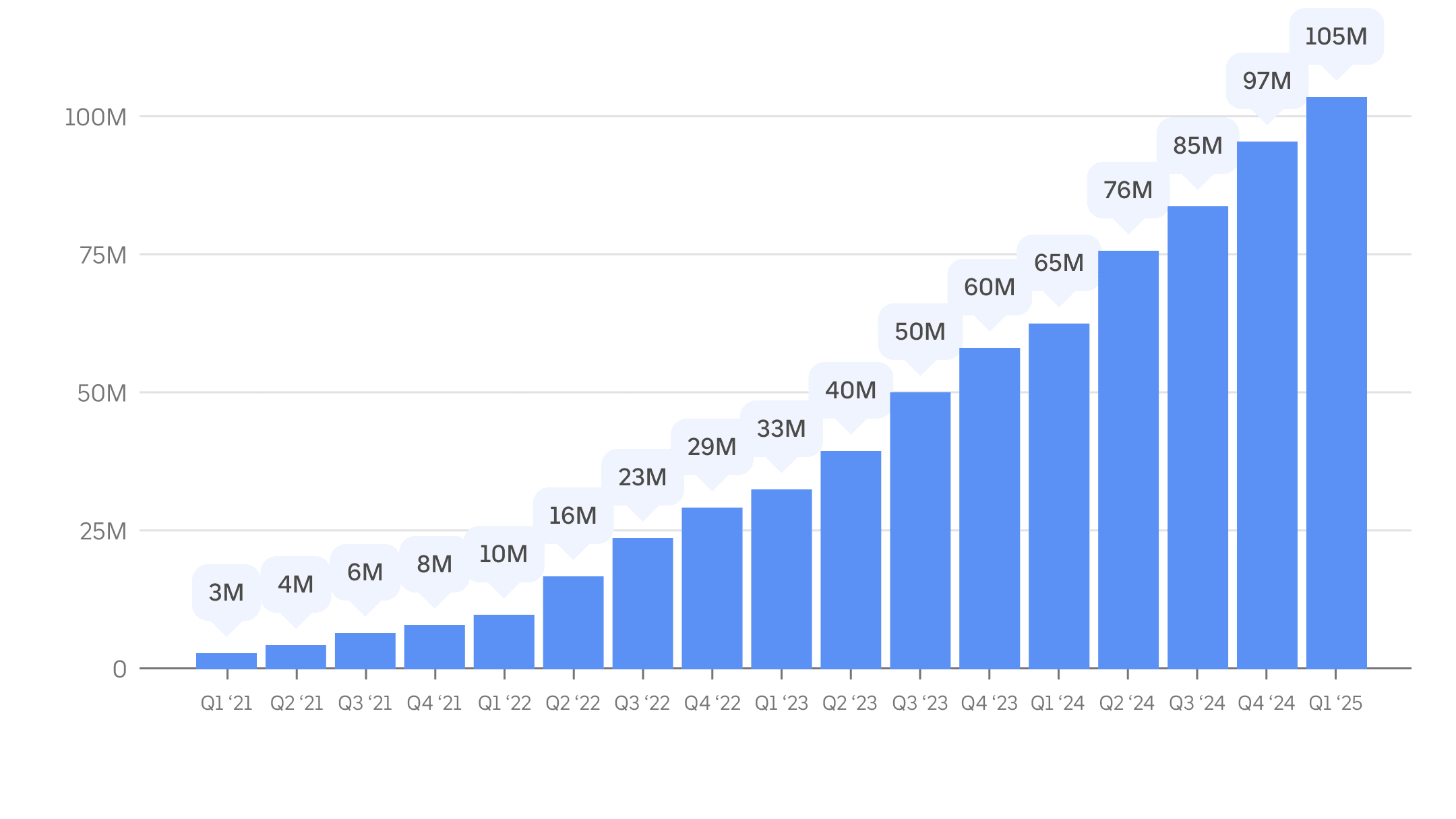
मेट्रिक: 2021 च्या पहिल्या तिमाहीपासून Uber ॲपवर आयोजित केलेल्या आणि ZEV ड्रायव्हर्सनी पूर्ण केलेल्या ट्रिप्सची संख्या.
ZEV अपटेक
2025 च्या पहिल्या तिमाहीत(Q1) ZEV ड्रायव्हर्सनी युरोपमधील सर्व ऑन-ट्रिप मैलांपैकी 15.3% आणि कॅनडा आणि यूएसमध्ये 9.1% ऑन-ट्रिप मैल पूर्ण केले—सामान्य लोकांमधील ड्रायव्हर्सपेक्षा स्वीकार करण्याची पातळी अनेक पटींनी जास्त आहे. 2024 BloombergNEF अहवाल यामध्ये प्रकाशित केलेली आकडेवारी युरोपमधील Uber चालकांनी घेतलेला ZEV अपटेक सामान्य वाहनधारकांच्या तुलनेत सुमारे 5 पट वेगवान होता असे दर्शवतो.
मागील 4 वर्षांमध्ये, युरोपमधील Uber वर सर्व-इलेक्ट्रिक ऑन-ट्रिप मायलेज शेअरमध्ये सरासरी वार्षिक वाढ अनुक्रमे 3.1 आणि 2.2 टक्के पॉइंट्स होती. त्या कालावधीत नोंदवलेली सर्वाधिक आणि सर्वात कमी वार्षिक वाढ ही मागील वर्षात झाली: 2024 च्या पहिल्या तिमाहीपासून(Q1), ZEV अपटेक युरोपमध्ये 6 टक्क्यांपेक्षा जास्त आणि अमेरिका आणि कॅनडामध्ये फक्त 1 पेक्षा कमी आहे.
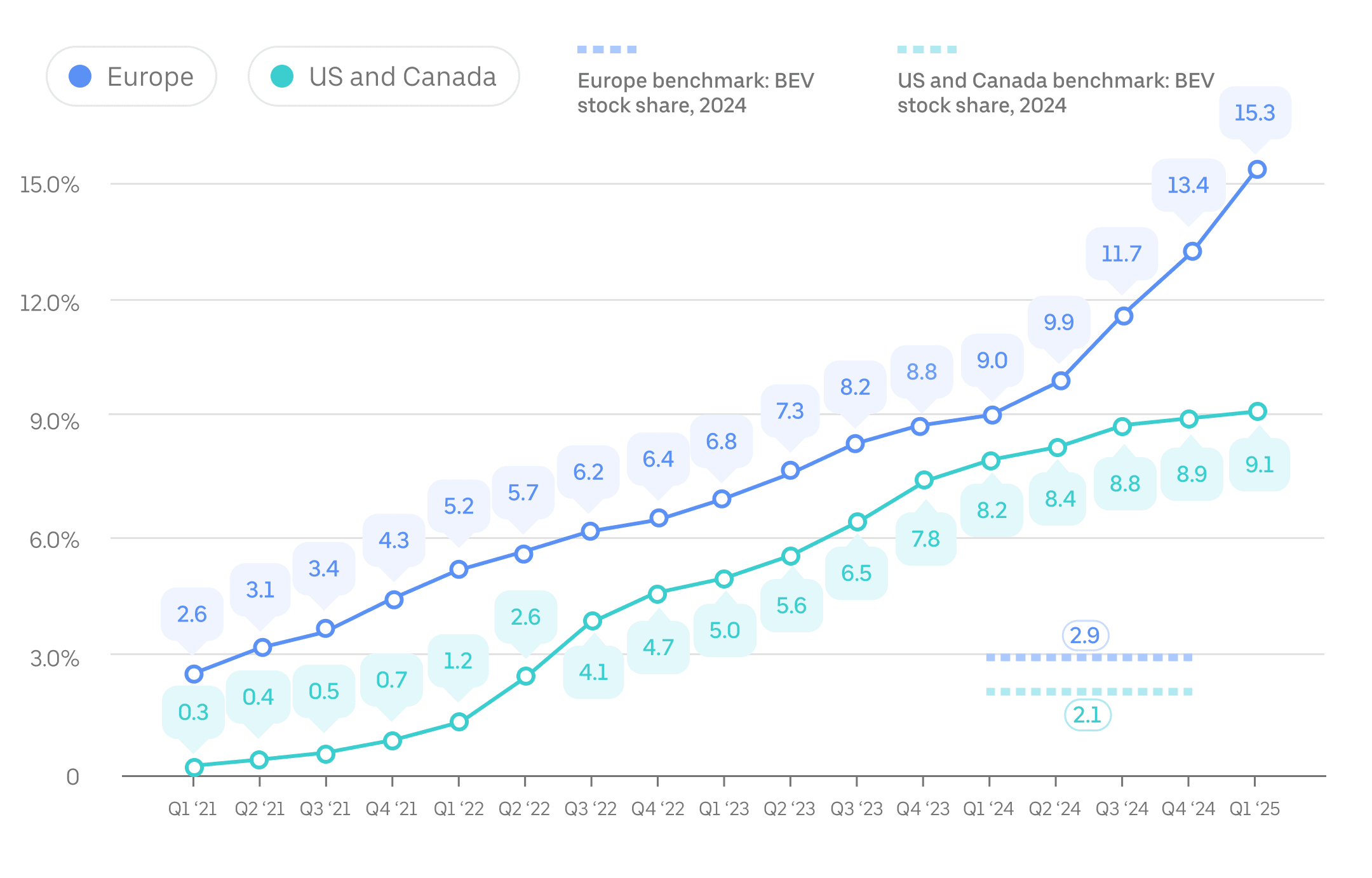
मेट्रिक: 2021 च्या पहिल्या तिमाहीपासून(Q1), Uber ॲपद्वारे व्यवस्था केलेल्या सर्व ऑन-ट्रिप मैलांच्या तुलनेत ZEV मध्ये पूर्ण केलेल्या ट्रिपवरील मैलांचा वाटा. कॅनडा, यूएस आणि युरोपियन बेंचमार्क डेटा 2024 चा आहे (या अपडेटच्या वेळी सर्वात अलीकडे उपलब्ध असले��ला) आणि वरून घेतला गेला आहे आंतरराष्ट्रीय ऊर्जा एजन्सी. “BEV” म्हणजे बॅटरीवर चालणारी इलेक्ट्रिक वाहने.
प्रवासी कार्बनची तीव्रता
2024 मध्ये, प्रवाशाने Uber वर प्रवास केलेल्या प्रत्येक मैलामुळे युरोपमध्ये सरासरी 197 ग्रॅम CO₂ (किंवा प्रति किलोमीटर 123 ग्रॅम CO₂) आणि अमेरिका आणि कॅनडामध्ये 340 ग्रॅम CO₂ (किंवा प्रति किलोमीटर 212 ग्रॅम CO₂) ची निर्मिती झाली ). 2021 च्य��ा तुलनेत, हे प्रवासी कार्बन तीव्रता मेट्रिक युरोपमध्ये 14% आणि यूएस आणि कॅनडामध्ये 6% कमी झाले.
सरासरी प्रवासी व्यस्ततेमध्ये किरकोळ घट झाल्यामुळे आणि “डेडहेडिंग” (प्रवाश्यांना पिकअप करण्यापूर्वी आणि वाटेवर लागलेले वाहन मायलेज) वाढल्यामुळे 2023 आणि 2024 दरम्यान युरोप, अमेरिका आणि कॅनडामधील प्रवासी कार्बनची तीव्रता किंचित वाढली.
मेट्रिक: प्रवासी कार्बनची तीव्रता, किंवा प्रति प्रवासी मैल प्रवास केलेल्या CO₂ चे अंदाजे ग्रॅम हे वार्षिक हवामान आहे आणि कार्यक्षमता मेट्रिक आहे Uber द्वारे —आणि जगभरातील देश आणि कंपन्यांकडून वाढत्या प्रमाणात वापरले जाते. राइडशेअरिंग किंवा कोणत्याही मागणीनुसार वाहतूक सेवेच्या बाबतीत, कोणत्याही डेडहेड मैल्समुळे होणारे उत्सर्जन मोजले जाते.
आम्ही प्रवासी कार्बन तीव्रतेची गणना कशी करतो याबद्दल अधिक तपशीलांसाठी, आमचे मेथोडॉलॉजी दस्तऐवज पहा . लक्षात असू द्या की Uber च्या युरोपमधील वाहनांसाठी यूएस आणि कॅनडाच्या तुलनेत लक्षणीयरीत्या कमी सरासरी इंधन अर्थव्यवस्था या 2 भौगोलिक क्षेत्रांमधील कार्बन तीव्रतेमधील तफावत स्पष्ट करते. युरोपमध्ये ड्रायव्हर्स Uber च्या ॲपवर वापरत असलेल्या वाहनांची रचना अधिक कार्यक्षम आहे, आणि त्यात ZEVs आणि हायब्रीड्सचे प्रमाण जास्त आहे, तसेच यूएसमधील इंधन अर्थव्यवस्था अहवालाची अधिक कठोर मानके देखील या विसंगतीला कारणीभूत आहेत. याव्यतिरिक्त, 2021 पूर्वी युरोपियन बाजारपेठांमध्ये पूर्ण झालेल्या ट्रिप्ससाठी प्रवासी कार्बन तीव्रतेची गणना करण्यासाठी आमच्याकडे पुरेसा इनपुट डेटा उपलब्ध नाही.
अंतर्दृष्टी आणि सखोल विचार
EVs फॉर एव्हरीवन: बॅलन्स्ड अडॉप्शन ऑफ अ मॅच्युअरिंग टेक्नॉलॉजी (2024)
शाश्वततेला अधिक प्राधान्य देणे (2024)
हाऊ टू स्पार्क इलेक्ट्रिक मोबिलिटी एक्रॉस युरोप (2024)
शाश्वत मार्गाने उत्सर्जनाची बचत करणे (2023)
Uber हे खाजगी कारपेक्षा मूलभूतपणे वेगळे का आहे (2021)
कार्बन तीव्रतेसाठी गतिशीलता मोजणे (2019)
नेहमी विचारले जाणारे प्रश्न
- Uber च्या इलेक्ट्रिफिकेशन अपडेटमध्ये काय आहे?
आमचे विद्युतीकरण अपडेट इच्छुक भागधारकांना Uber ॲपद्वारे स��क्षम केलेल्या प्रवासी वाहन ट्रिप्ससाठी कार्बन-संबंधित उत्सर्जन आणि विद्युतीकरणावरील कामगिरीवर आधारित मेट्रिक्स प्रदान करते.
- तुम्ही हा अहवाल का प्रकाशित करत आहात?
आमच्या वाहतूक सेवा प्लॅटफॉर्मच्या वास्तविक-जागतिक वापरावर आधारित असलेले हे अपडेट, आमच्या विद्युतीकरणाच्या प्रभावाची अधिक पारदर्शकता दर्शवण्यात मदत करते आणि आमच्या प्लॅ�टफॉर्मवरील कार्यक्षमतेस सहाय्य करण्यासाठी आमच्या प्रयत्नांमध्ये सुधारणा करण्यात आम्हाला मदत करते.
- तुम्ही इलेक्ट्रिफिकेशन अपडेटमध्ये कोणते प्रमुख मोजमाप वापरत आहात?
मेट्रिक्समध्ये खालील गोष्टींचा समावेश आहे:
- Uber वरील ड्रायव्हर्सचा ZEV अपटेक (ZEVs मध्ये पूर्ण केलेल्या ट्रिपवरील मैल किंवा किलोमीटरचा वाटा), जे 2040 पर्यंत Uber वर 100% शून्य-उत्सर्जन गतिशीलतेच्या आमच्या ध्येयाकडे असलेल्या आमच्या प्रगतीचे मोजमाप करते
- कार्बनची तीव्रता, जे प्रत्येक प्रवासी मैलामुळे होणारे उत्सर्जन मोजते
- हा अहवाल Uber वरील राईड्ससाठी उत्सर्जन कमी करण्यात आणि विद्युतीकरणाचा वेग वाढविण्यात कसे सहाय्य करेल ?
ट्रिप्�समधील प्रवासी कार्बन तीव्रता कमी करणे आणि Uber वर शून्य-उत्सर्जन वाहनांचा वापर वाढवणे या आमच्या साहसी महत्त्वाकांक्षा आहेत. प्रगतीचे मोजमाप आणि पारदर्शकता हे आमच्या प्रवासातील महत्त्वाचे टप्पे आहेत.
- रायडर्स लो-कार्बन पर्याय वापरण्याऐवजी Uber सह ट्रिप्स घेणे पसंत करतात का ?
Uber अॅपसह राईड्स हा राईड शोधत असलेल्या लोकांसाठी उपलब्ध असलेल्या अनेक वाहतुकीच्या पर्यायांपैकी एक आहे. ट्रिपची निवड ही अनेक स्थानिक बाजार परिस्थितींवर अवलंबून असते. आमचे यूएस राष्ट्रीय घरगुती प्रवास सर्वेक्षण डेटाचे विश्लेषण दर्शवितो की सर्वात शाश्वत वाहतूक पर्यायांचा (ट्रांझिट, चालणे आणि बाइकिंग) प्रति-कुटुंब उच्च वापर हा राइडशेअरिंग आणि इतर मागणीनुसार उपायांच्या उच्च वापराशी संबंधित आहे.
- तुम्ही तोच डेटा जगभरातील इतर देशांसाठी किंवा प्रदेशांसाठी मोजता का?
वरीलपैकी बरेच मेट्रिक्समध्ये आता जागतिक स्तरावर Uber ॲपसह पूर्ण केलेल्या सर्व प्रवासी ट्रिप्सचा समावेश आहे. आम्ही Uber वरील ट्रिप्समुळे होणारे हवामान उत्सर्जन आणि इतर प्रभाव क्षेत्रांबद्दल नियमित रिपोर्ट देण्यासाठी वचनबद्ध आहोत.
- तुम्ही किती वारंवार Uber चे इलेक्ट्रिफिकेशन अपडेट देणे अपेक्षित आहे?
आम्ही किमान दरवर्षी सर्व मेट्रिक्स अपडेट करतो आणि उपलब्ध असल्यास काही मेट्रिक्स वारंवार अपडेट करू शकतो. आम्ही कॅलेंडर वर्षानुसार एकत्रित केलेले, दरवर्षीचे उत्सर्जन मेट्रिक्स, (जसे की प्रवासी कार्बन तीव्रता), सादर करण्याची योजना आखत आहोत.
- “शून्य-उत्सर्जन वाहन” म्हणजे काय?
आम्ही "शून्य-उत्सर्जन वाहन" (ZEV) या शब्दाचा त्याच प्रकारे प्रयोग करतो ज्याप्रकारे कॅलिफोर्निया एअर रिसोर्सेस बोर्ड (CARB) आणि युरोपची वाहतूक आणि पर्यावरण (T&E) तो वापरतात: म्हणजेच ऑन-बोर्ड उर्जा स्त्रोतापासून थेट CO2 उत्सर्जन न करणारी किंवा इतर निकष वायू प्रदूषक (जसे की NOx, कण द्रव्य, CO2 आणि SOx) निर्माण न करणारी वाहने संबोधण्यासाठी. शब्दांच्या प्रादेशिक फरकांचा वाचकांनी विवेकबुद्धीनुसार विचार करणे आवश्यक आहे .
Uber चे ॲप वापरणारे ड्रायव्हर्स आज 2 प्रकारची ZEVs वापरतात: बॅटरी इलेक्ट्रिक वाहने (बॅटरी ईव्ही) आणि कधीकधी, हायड्रोजनवर चालणारी इंधन सेल इलेक्ट्रिक वाहने (FCEVs).
अर्थात, ZEV मधील “शून्य” म्हणजे वाहनाच्या “टेलपाइप” मधून कोणतेही उत्सर्जन होत नाही असा होतो पण उत्पादनापासून ते वाहनाची विल्हेवाट लावण्यापर्यंत आणि वाहनाच्या उर्जा स्त्रोतामुळे होणाऱ्या सर्व उत्सर्जनांचा त्यात समावेश आहे असे नाही. तथापि, सर्व हिशोबित, स्वतंत्र तज्ञांद्वारे जीवन-चक्र विश्लेषणे दर्शवितात की “आज नोंदणी केलेल्या सरासरी मध्यम-आकाराच्या बॅटरी ईव्ही वाहनांच्या आयुष्यातील उत्सर्जन हे तुलना करण्यायोग्य पेट्रोल कार्सपेक्षा युरोपमध्ये 66%–69%, युनायटेड स्टेट्समध्ये 60%–68%, चीनमध्ये 37%–45%, आणि भारतात 19%–34% इतके कमी आहे.”
- तुम्ही तुमच्या डिलिव्हरी व्यवसायावर होणारा प्रभाव मोजाल का?
आमच्या विद्युतीकरण अपडेटमध्ये सध्या केवळ आमच्या वाहतूक सेवा व्यवसायासाठी (राइडशेअरिंग) विद्युतीकरण आणि उत्सर्जन मेट्रिक्स समाविष्ट आहेत. भविष्यात डिलिव्हरी उत्सर्जन आणि विद्युतीकरणावरील आमची प्रगती समाविष्ट करण्याचे आमचे उद्दिष्ट आहे.
Uber पॅकेजिंगसाठी व्यापाऱ्यांना शाश्वत पर्यायांकडे वळण्यासाठी मदत करण्यासाठी गुंतवणूक करत आहे. तथापि, विद्युतीकरणाप्रमाणेच प्रगती ही सामूहिक कृतीवर अवलंबून असते. आम्ही शहरांमध्ये जिथे सार्वजनिक आणि खाजगी गुंतवणूक एकत्रित आहेत तिथे प्रयत्न करण्यास प्राधान्य देत आहोत. उदाहरणार्थ, फ्रान्समध्ये प्लॅटफॉर्मवर वापरलेले 60% पेक्षा जास्त पॅकेजिंग पुनर्वापर करण्यायोग्य, पुन्हा वापरण्यायोग्य किंवा कंपोस्ट करण्यायोग्य आहे, ज्याला राष्ट्रीय धोरण आणि स्थानिक इंसेंटीव्ह यांचे समर्थन आहे.
सध्याच्या ट्रेंडच्या आधारे प्रगती केली जात असली तरी, आम्ही 2025 ची सर्व उद्दिष्टे पूर्ण करू शकत नाही आणि सरकार आणि उद्योगधंद्यांवरील मजबूत, समन्वित कृतीशिवाय आमची 2030 ची उद्दिष्टे आवाक्याबाहेर असतील.
अनेक महत्त्वाची धोरणे आमच्या नियंत्रणाबाहेर असताना, आम्ही या परिवर्तनासाठी मनापासून वचनबद्ध आहोत. व्यापाऱ्यांसाठी अधिक शाश्वत पॅकेजिंगबाबत Uber च्या दृष्टिकोनाबद्दल अधिक जाणून घेण्यासाठी, आमच्या Uber Eats for Merchants या वेबपेजवरून मार्गदर्शन मिळवा.
- Uber स्कोप 1, 2 आणि 3 उत्सर्जन उघड करते का आणि तसे असल्यास ते कुठे सापडतील?
Uber CDP साठी स्कोप 1, 2 आणि 3 उत्सर्जन उघड करते. तुम्ही आमचा सर्वात अलीकडील स्कोअर CDP च्या सार्वजनिक कॉर्पोरेट स्कोअर सर्च मध्ये पाहू शकता. या उत्सर्जन अंदाजांना स्वतंत्र तृतीय पक्षाकडून मर�्यादित आश्वासन मिळाले आहे.
ही साइट आणि संबंधित हवामान मूल्यांकन आणि कामगिरी रिपोर्ट (“रिपोर्ट”) मध्ये आमच्या भविष्यातील व्यवसायातील अपेक्षा आणि उद्दिष्टे या संबंधित पुढे नेणारी स्टेटमेंट्स आहेत ज्यात जोखीम आणि अनिश्चितता समाविष्ट आहेत. वास्तविक परिणाम अपेक्षित परिणामांपेक्षा फार वेगळे असू शकतात. याव्यतिरिक्त, हा अहवाल केवळ माहितीच्या उद्देशाने प्रदान केला आहे आणि व्यवसाय किंवा वाहन संपादनाच्या निर्णयांसाठी त्यावर अवलंबून राहू नये. भविष्यातील वाटणाऱ्या विधानांवर अवाजवी भरवसा ठेवू नये. कायद्यानुसार आवश्यक असल्याशिवाय ही माहिती अपडेट करण्याचे कोणतेही कर्तव्य आम्ही पार पाडत नाही. Uber च्या धोरणाबद्दल अधिक माहितीसाठी कृपया investor.uber.com येथे जा.
या अहवालात उघड केलेल्या काही डेटाला LRQA कडून मर्यादित आश्वासन मिळाले आहे. राउंडिंग पद्धतींमुळे अॅश्युरन्स आणि डेटामधील विसंगती असू शकतात.
या अहवालात “ड्रायव्हर्स,” “कुरियर्स,” “कमाई करा,” “शून्य- उत्सर्जन वाहन," आणि "शाश्वत पॅकेजिंग" या संज्ञांचा केलेल्या अत्यंत वापर सामान्य आहे आणि Uber Technologies, Inc. च्या सामान्य वापराच्या केसचे पालन करतात. शब्दांच्या प्रादेशिक फरकांचा वाचकांनी विवेकबुद्धीनुसार विचार करणे आवश्यक आहे .
Uber r' च्या कार्बन ऑफसेट्सच्या वापराचा आढावा येथेघेतला जाऊ शकतो .
याच्या विषयी
